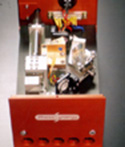REG Researcher
Dr Nikolaus Metzger, University of St Andrews
The best commercially available microwave local oscillators are based on ultra-low-noise quartz crystals with frequency stabilities of around 8 x 1014 at 1 s. This limits performance in some leading-edge applications such as radar, but higher-stability alternatives such as cryogenic sapphire oscillators are unacceptable due to their high maintenance cost.
An alternative technology for the generation of low noise microwave signals is provided by a femtosecond optical frequency comb stabilized to an ultrastable optical oscillator. Although this approach has been demonstrated successfully in a laboratory environment, current state-of-the-art technology is too bulky and complex to be applied in an industrial environment and improvements in the phase noise of the derived microwave signal at high Fourier frequencies are highly desirable.
 The work of the REG researcher is to address these issues by developing a compact and user-friendly femtosecond laser system that can generate sub-200-fs pulses at a high pulse repetition frequency (>500 MHz). This laser is to be used to generate an octave-spanning frequency comb, enabling the laser to be fully stabilized to deliver a train of pulses with ultralow timing jitter, from which low phase noise microwave signals can be derived. In addition to being better suited for deployment in an industrial environment, the high pulse repetition frequency is expected to result in improved signal-to-noise in the derived microwave signal and consequently improved phase noise performance at high Fourier frequencies.
The work of the REG researcher is to address these issues by developing a compact and user-friendly femtosecond laser system that can generate sub-200-fs pulses at a high pulse repetition frequency (>500 MHz). This laser is to be used to generate an octave-spanning frequency comb, enabling the laser to be fully stabilized to deliver a train of pulses with ultralow timing jitter, from which low phase noise microwave signals can be derived. In addition to being better suited for deployment in an industrial environment, the high pulse repetition frequency is expected to result in improved signal-to-noise in the derived microwave signal and consequently improved phase noise performance at high Fourier frequencies.
This work is being carried out at the University of St Andrews Ultrashort-Pulsed Laser Research Group, headed by Dr Tom Brown
People involved
Dr Thomas A. Brown
 Tom Brown received a BSc. degree from Imperial College in 1993. Following a spell working for DRA Farnborough he moved on to the Optoelectronics Research Centre, University of Southampton where he completed a PhD in crystal waveguide lasers and amplifiers. After his PhD Tom worked in IT development for a leading investment bank before moving to St Andrews to study semiconductor non-linear optics. He was appointed as a SUPA Biophotonics lecturer in the School of Physics & Astronomy in 2005.
Tom Brown received a BSc. degree from Imperial College in 1993. Following a spell working for DRA Farnborough he moved on to the Optoelectronics Research Centre, University of Southampton where he completed a PhD in crystal waveguide lasers and amplifiers. After his PhD Tom worked in IT development for a leading investment bank before moving to St Andrews to study semiconductor non-linear optics. He was appointed as a SUPA Biophotonics lecturer in the School of Physics & Astronomy in 2005.
Dr Nikolaus K. Metzger
 Klaus received an Engineering degree from the FH Muenchen working on a regenerative fs-amplifier for his thesis. After completing the MSc course in Laser physics at Heriott-Watt University he went on to work in industry on high power Nd:YAG Lasers as well as Extended Cavity Diode Laser systems. In 2007 he completed his PhD at St Andrews University looking at the nonlinear dynamics of optically bound matter in a dual fibre optical trap.
Klaus received an Engineering degree from the FH Muenchen working on a regenerative fs-amplifier for his thesis. After completing the MSc course in Laser physics at Heriott-Watt University he went on to work in industry on high power Nd:YAG Lasers as well as Extended Cavity Diode Laser systems. In 2007 he completed his PhD at St Andrews University looking at the nonlinear dynamics of optically bound matter in a dual fibre optical trap.
For more information: Patrick Gill
